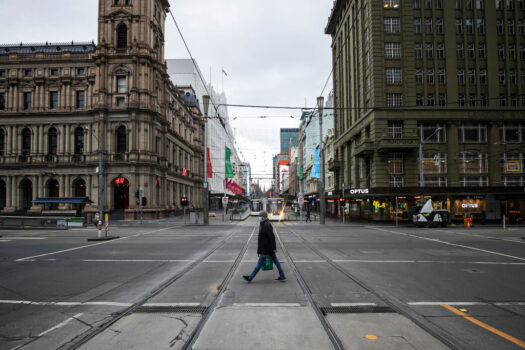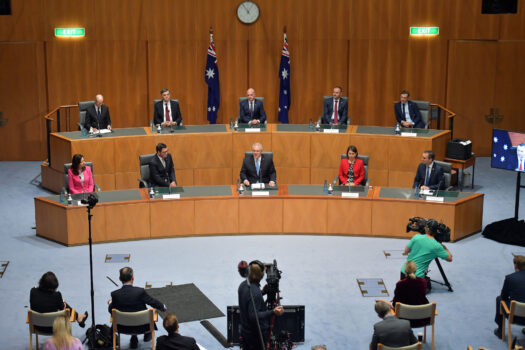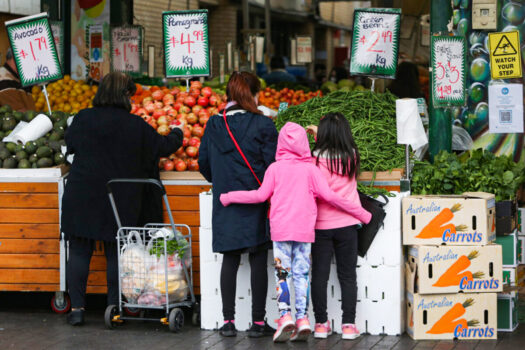Review Pans Australia’s Use of Lockdowns, School Closures
Distressed Patriotic Flag Unisex T-Shirt - Celebrate Comfort and Country $11.29 USD Get it here>>

A year on from some of Australia’s heaviest lockdowns, one of the largest non-government reviews into the country’s response has labelled many of the adopted policies “unprecedented” while criticising the use of lockdowns as “excessive” and “harsh.”
“They proved to be a blunt instrument,” according to ‘Fault lines: An independent review into Australia’s response to COVID-19’ which also found politicking was never far from the decision-making of state leaders responsible for deploying lockdowns and internal border closures.
“Initially, an anxious Australia seemed to accept that far-reaching lockdowns were necessary, even desirable. But the balance between the costs and benefits of lockdowns swung towards costs long before governments were willing to lift them,” the review said.
“Many lockdowns were avoidable. Some were the result of failures in our quarantine systems, our contact tracing systems, a sluggish vaccine rollout and shortcomings in our communication with key parts of our community.

“Some decisions were politically motivated. Some responded to public fear whipped up by the media.”
The report was chaired by Peter Shergold, the Chancellor of Western Sydney University, along with a panel comprising of Jillian Broadbent, a director at global financial services firm Macquarie Group, Isobel Marshall, the 2021 Young Australian of the Year and a social enterprise worker, as well as Peter Varghese, chancellor of the University of Queensland. They were supported by the e61 Institute.
The panel also noted lockdowns exacerbated inequity between the poorer parts of Australia’s cities versus the wealthier areas and that further research was needed into the potential long-term mental health consequences of residents enduring government restrictions.
Politics Never Strayed Far from COVID Policy
The group noted that “political calculation was never far from the surface of COVID-19 decisions.”
“It became clear that experts (both within and outside government) often differed in their advice. Government leaders cannot abdicate their responsibility for decisions, especially those that had long-term consequences such as lockdowns and mandatory health orders,” the report stated.
The panel said politics weakened the effectiveness of the National Cabinet, which was formed to help coordinate the state and federal response to COVID-19 but lacked real executive power.
“State leaders insisted on going their own way, emboldened by their constitutional prerogatives,” the report said. “Tough action on COVID-19, including the decision to close schools, was judged politically popular by many state leaders. Until that popularity subsided and such policies were relaxed.”

“Nothing captures the political drivers of many COVID-19 decisions better than the shift from harsh mandatory health orders in 2020 and 2021 to embracing personal choice in 2022.
The COVID-19 response from state governments is believed to have contributed to election victories for several incumbent leaders over the course of 2020 to 2021.
Further, tensions between the predominantly Labor-led state governments and the federal Liberal-National Coalition would emerge with disputes over funding for initiatives like free Rapid Antigen Testing and quarantine facilities.
Schools Should Not be Closed
The panel said schools should stay open in future health crises unless there was enough strong evidence to suggest otherwise.
“Clear cost-benefit and risk management frameworks should be established. Closures should be targeted so that only specific schools are closed and not entire school systems,” the report stated.
“Sweden, controversially, decided to keep schools open during the pandemic, relying on good hygiene and awareness of social distancing to lower the likelihood of infection,” it added. “Yet the incidence of acute COVID-19 in children remained low.”
The panel said less than 0.02 percent of Swedish teachers required intensive care, and children did not suffer the same loss of learning opportunities as those in other countries.
Further, according to New South Wales (NSW) Mental Health Commission, 60 percent of parents of senior secondary school students believed their children were negatively affected by school closures during the harshest lockdowns in the state in 2021.
“Early evidence suggests that high school students in NSW fell many months behind in their learning after missing more than a term of face-to-face learning during the 2021 lockdown.”
School closure policies also forced mothers to drop out of the workforce to take care of their children. While other issues such as mental health problems, increased alcohol consumption, and a lack of physical exercise resulted.
Australia’s Reputation, Economy Damaged
The panel said Australia’s international reputation also took a battering in response to the global attention its lockdowns received.
Extensive restrictions on international borders have resulted in workforce numbers plummeting, with the country now needing another 190,000 workers to service the economy.
“Governments and the Reserve Bank of Australia understandably over-insured in response to the crisis,” the report said. “But we are now living with some of the costs of that over-insurance as inflation and interest rates rise sharply.”

Across developed countries, interest rates and inflation are rising in lockstep as central banks attempt to keep a lid on the rising price of basic goods and services. The problem stems from the over-printing of currency by governments and reserve banks as they subsidised businesses and individuals unable to work during lockdowns.
“[This] insurance hasn’t come free. Federal government net debt has risen from 19 percent of GDP in 2019 to 28 percent of GDP in 2022,” the report said.
“It will take more than 20 years to return to Australia’s pre-COVID debt-to-GDP level if the economy returns to its long-run GDP growth rate,” it continued noting that debt across state and territory governments was four times as high compared to 2019 levels.
“Restoring fiscal policy buffers is essential to provide sufficient firepower to respond to the next crisis. Governments will need to decide who should bear the cost of budget repair and how much of it will fall on young people.”
The report is funded by the Paul Ramsay Foundation, the Minderoo Foundation (backed by billionaire Andrew Forrest), and the John and Myriam Wylie Foundation.





